.svg)

You meet a potential client, exchange cards, and then a week later, the contact is gone how much business do you lose because the details don't stick? Intelligent digital business card design fixes that by making contact sharing instant, searchable, and easy to update, so networking actually moves your work forward. If you want an easy, modern way to share and manage business contacts seamlessly without the limitations or costs of HiHello, consider exploring practical alternatives, such as virtual business card apps, NFC business cards, QR code business cards, CRM-friendly contact management, smart business cards, and eco-friendly electronic vCard options.
Mobilo's Digital Business Card offers a clean, modern way to share a customizable digital card via NFC or QR code, capture leads, sync with popular CRM systems, and add contacts to your mobile wallet, allowing you to manage relationships without the limitations or costs of HiHello.
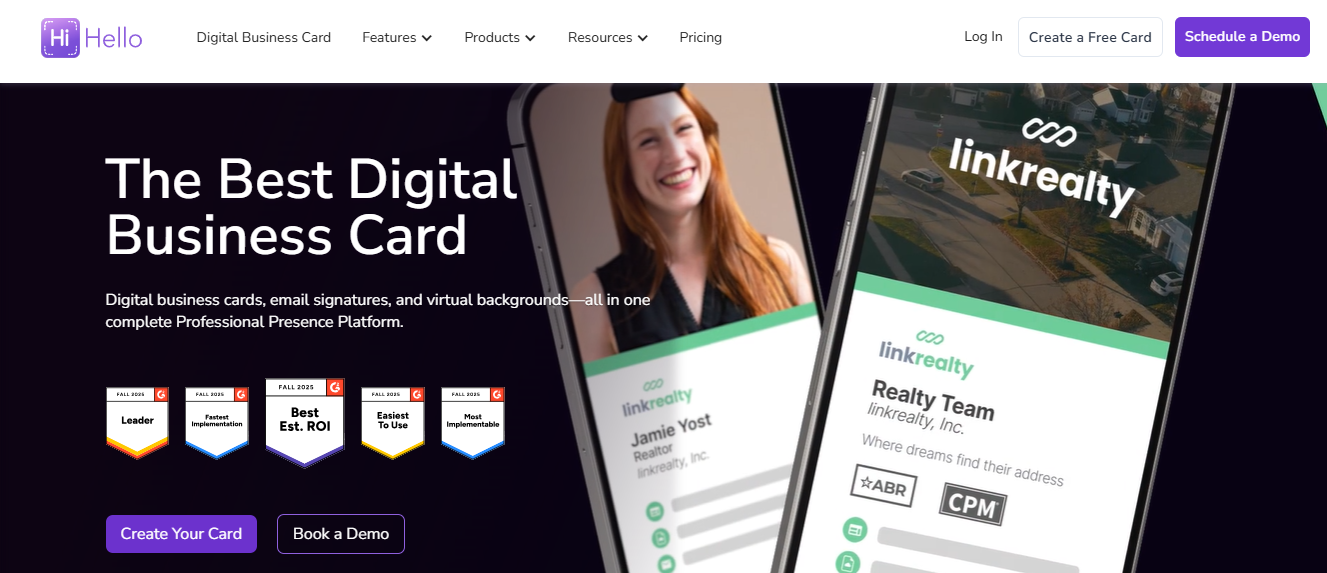
You look for HiHello alternatives when the platform stops being a helpful shortcut and starts creating work, expense, or missed opportunities for your team. Pain manifests as rising costs, support that fails to resolve urgent problems, and limits that necessitate manual workarounds rather than scalable processes.
Pricing matters because digital cards are a recurring operational expense, not a one-time app purchase. When budgets tighten, teams notice small increases become big headaches. That becomes urgent when HiHello's pricing increased by 25% in the last year.
The 2023 Market Analysis Report explains why procurement and revenue teams begin to question whether the platform actually saves time at scale, rather than just appearing visually appealing.
Support is the safety net. When it underperforms, minor problems balloon into pipeline risks. The decision makers you work with stopped trusting a tool after its escalation queues left event leads unanswered, and the pattern is consistent: Over 70% of users reported dissatisfaction with HiHello's customer support.
User Satisfaction Survey. That dissatisfaction translates into slower follow-up, frustrated reps, and higher churn for sales processes that depend on timely contact capture.
This challenge is evident across marketing and sales teams: limited free customization forces people into cumbersome workarounds. When we audited digital-card workflows during a 12-week conference push, teams wasted time stitching branded landing pages together, exporting contacts into spreadsheets, and manually editing profiles to match campaign collateral.
The irritation is real, and the consequence is measurable: manual chores displace selling time, making events less profitable.
The failure point is usually contact hygiene. Apps that lack robust merge, dedupe, or bulk-edit tools make address books noisy.
That noise hides real leads and forces reps to reconcile records after the fact, which kills momentum. Teams relying on basic features end up running reconciliations after every significant event, turning a single source of truth into a recurring maintenance project.
Most teams continue to use a single-card app because it is familiar and quick to deploy; however, this familiar path has a hidden cost: fragmentation of follow-up and inconsistent lead routing as teams scale. Teams find that platforms designed for enterprise needs, with:
Compress the handoff from introduction to action, turning scattered contacts into prioritized, trackable leads rather than a backlog of tasks.
It is exhausting when the tool you chose adds steps to basic tasks. Sales reps lose confidence when they cannot reorganize a card layout, marketers bristle at the limited brand controls, and admins resent the need for manual exports just to sync records. That quiet friction chips away at adoption, and adoption is the single most significant determinant of whether a digital-card program will pay off.
Think of the wrong platform like a toolbox missing the wrench you need most, so you improvise, slow down, and leave the job half-finished, except the job is your pipeline, and the delay costs you meetings and momentum.
The surprising part is not that teams switch vendors, but why they switch so quickly when they do. Once you see what’s next, this choice starts to feel urgent.
These alternatives provide practical choices, depending on whether you need lead capture, admin control, low cost, or simple tap-and-go sharing. Each entry below highlights the trade-offs, allowing you to match capability to your workflow.
Also, point out which teams I would steer toward each app and why, because the wrong fit is often the root cause of adoption failure. Switching to digital cards lowers ongoing printing and distribution budgets, a fact underlined by Mobilocard's 2025 finding that digital business cards can save up to 90% of the cost compared to traditional paper cards.
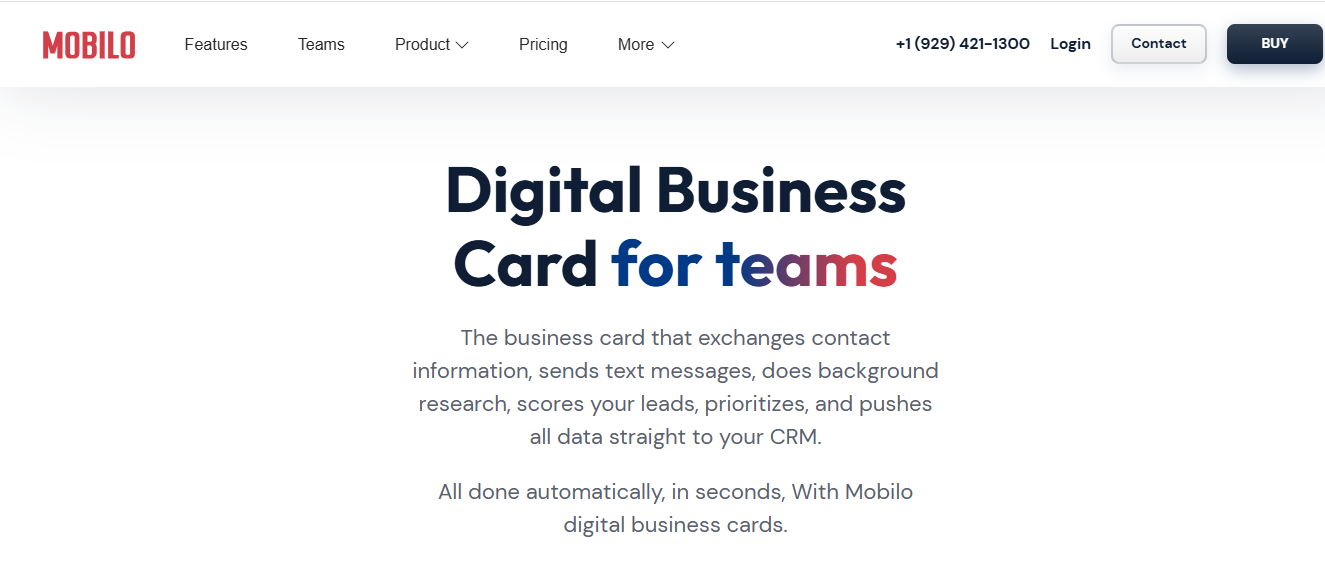
Pros:
Mobilo focuses squarely on turning event encounters into tracked opportunities. Where HiHello is oriented toward clean personal profiles, Mobilo builds workflows: when a rep taps a card at a conference, that interaction can trigger enrichment, scoring, and a routed task in the CRM. That shift matters because capturing a name is only half the battle; the follow-up cadence and routing determine whether a contact becomes part of the pipeline.
For teams that measure networking in opportunities rather than impressions, Mobilo reduces the friction between handshake and action. If your priority is consistent lead capture at scale, integrated enrichment, and analytics that hold reps accountable, Mobilo is engineered for that path.
Outbound sales teams, event staff, and field reps need immediate lead capture routed into CRM workflows. It fits organizations that value measurable follow-up, native integrations, and physical NFC options for on-site efficiency.

Pros:
Cons:
ShareEcard is a good on-ramp for individuals and small teams just want to ditch paper without a budget commitment. Compared to HiHello, it sacrifices enterprise continuity for immediate zero-cost adoption; you get the basics fast, without admin overhead. Usability is the selling point: a few clicks and a shareable card are created, which lowers the barrier to adoption among less technical staff.
If your goal is a low-friction, green alternative that works for networking, recruiters, or independent consultants, ShareEcard provides a no-budget route to digitize cards and reduce waste.
Freelancers, early-stage founders, and nonprofit staff need free, straightforward digital cards and simple sharing, rather than deep integrations or branding control.
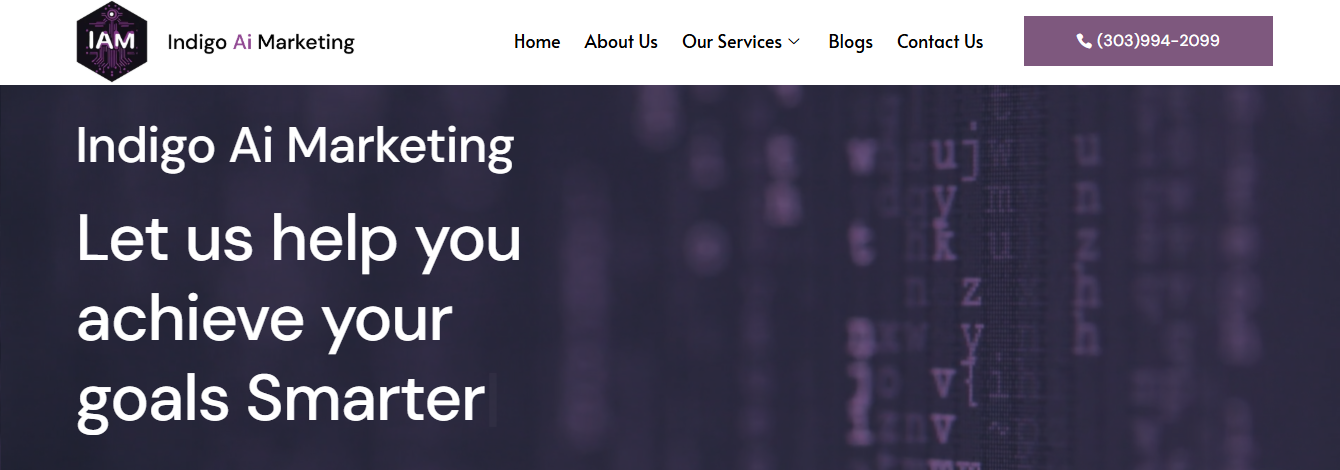
Pros:
Cons:
Inigo leans into engagement: the card is a mini landing page meant to pull a click, a view, or a conversion. Compared with HiHello, Inigo offers more marketing-oriented tools out of the box, including built-in CTAs and audience-level analytics for campaigns. That makes it worthwhile when cards are part of a content funnel rather than purely a contact exchange.
Choose Inigo when you want to measure how recipients interact with your card content and when each card should drive a specific action, like booking a demo or viewing a product video.
Marketing teams, growth managers, and solo consultants utilize cards as conversion tools, seeking measurable engagement rather than merely capturing contacts.

Pros:
Cons:
CamCard solves the classic messy backlog: stacks of paper cards that never make it into your contact system. Where HiHello focuses on a live profile, CamCard focuses on converting legacy physical contacts into structured data, then letting you export and clean it. That makes it an operational tool for teams migrating years of contacts into a CRM or preparing for outreach.
Use CamCard when your immediate need is contact hygiene and bulk ingestion, and when you prefer exporting to manipulate data before it reaches your live systems.
Sales operations, event follow-up teams, and administrators require accurate OCR and bulk exports to reconcile offline contacts with digital systems.
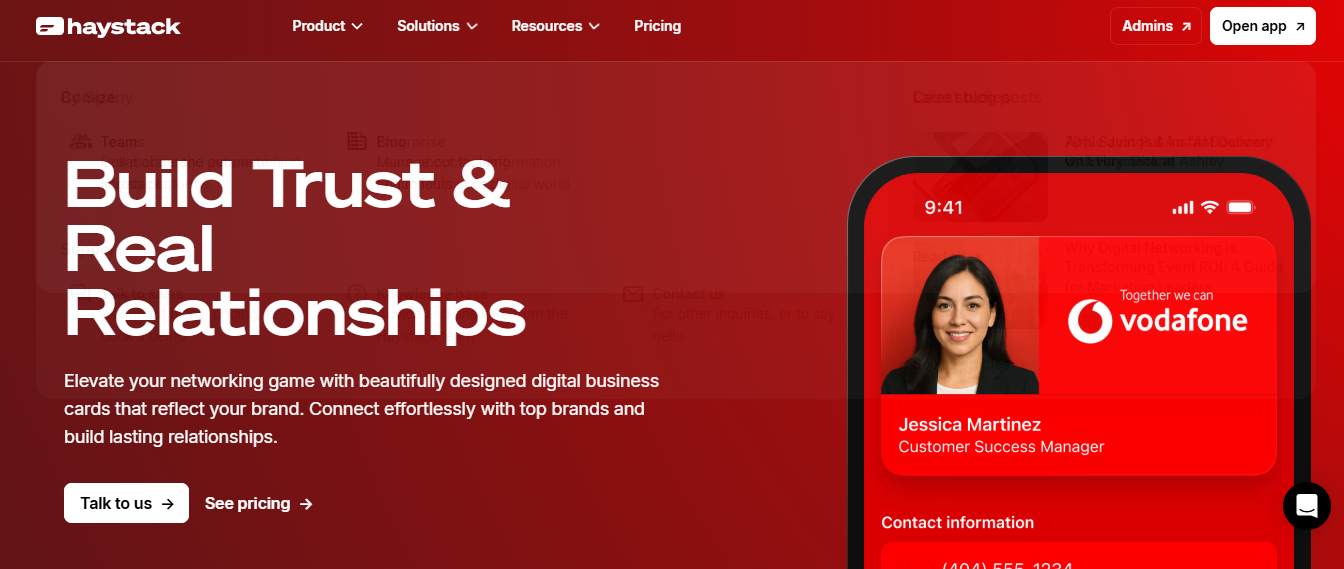
Pros:
Cons:
Haystack is a practical balance between strong visual branding and reliable sharing. Compared to HiHello, Haystack places more emphasis on consistent brand presentation across channels, making it suited for client-facing roles where image matters. It provides a professional, multi-channel card without a significant administrative burden.
If your priorities are brand consistency and straightforward team adoption, Haystack maintains creative control while remaining approachable.
Account managers, consultants, and small marketing teams that want polished, brand-forward cards that can be easily shared across email, text, and wallets.
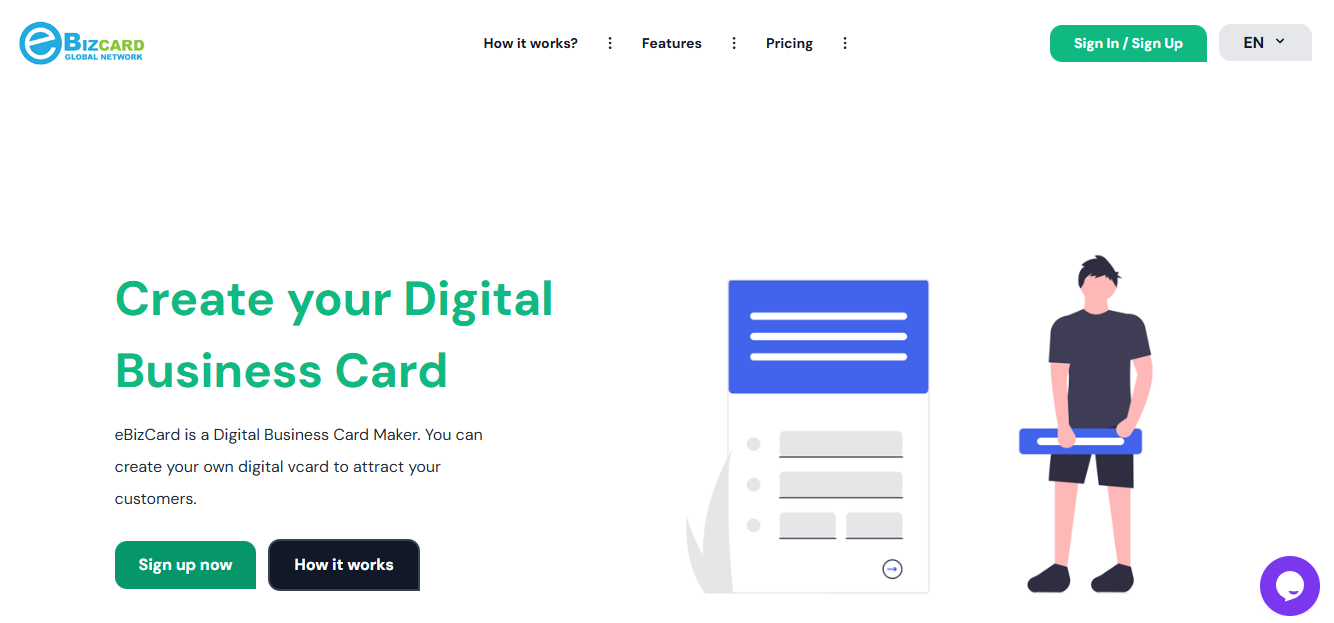
Pros:
Cons:
EBizCard sits in the pragmatic end of the market. If HiHello gives you a modern profile, EBizCard gives you enterprise-friendly export and import tools for IT processes. It’s a sensible choice when you need to perform bulk operations, maintain clean data flows to legacy systems, and ensure predictable export formats for reporting.
Pick EBizCard when your priority is moving and normalizing contact data across established systems without bespoke engineering effort.
IT teams, legal and compliance functions, and operations groups that need standardized exports and integrations with classic enterprise tools.
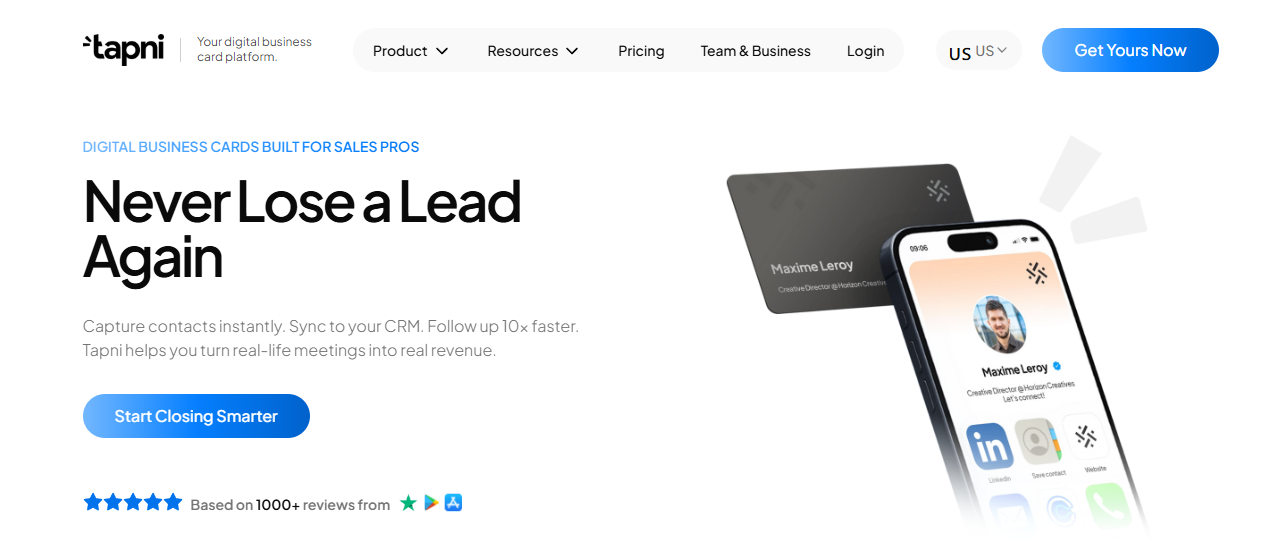
Pros:
Cons:
Tapni stands out when form factor matters. If you want a badge at a tradeshow or a sticker attendees can take home, Tapni supplies options. HiHello does not. The extra physical variety changes how people interact with your brand at events, increasing scan opportunities and recall.
For teams that run experiential marketing or want creative giveaways that still capture leads, Tapni pairs design variety with the technical backbone to push contacts into CRMs.
Event marketers, experiential teams, and brands that use physical touchpoints as a lead source need multiple sharing formats.
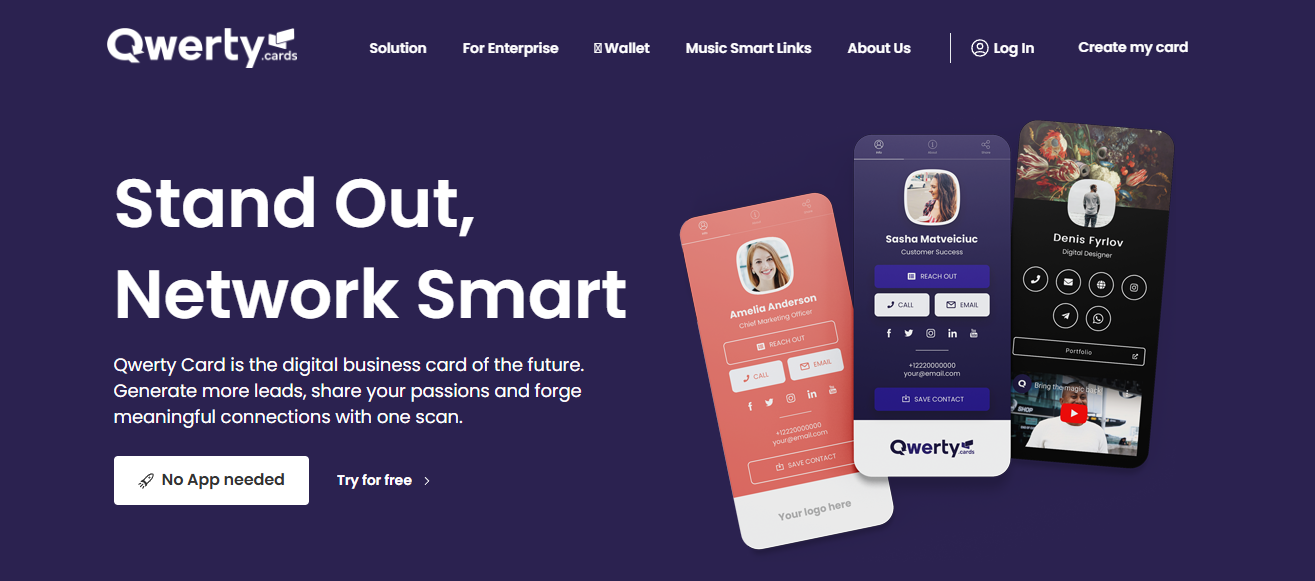
Pros:
Cons:
Qwerty gives you flexible profiles and easy team management without an app dependency for recipients. Where HiHello emphasizes profile polish, Qwerty emphasizes pragmatic multi-profile sharing and centralized edits, which is handy for professionals who wear multiple hats. The lack of a preview before checkout is a friction point, but the underlying promise of multi-profile switching is practical.
Choose Qwerty if you toggle between public and private identities and need simple centralized control over those profiles.
Professionals with multiple roles, small agencies, and teams that need quick profile swaps and centralized dashboard editing.
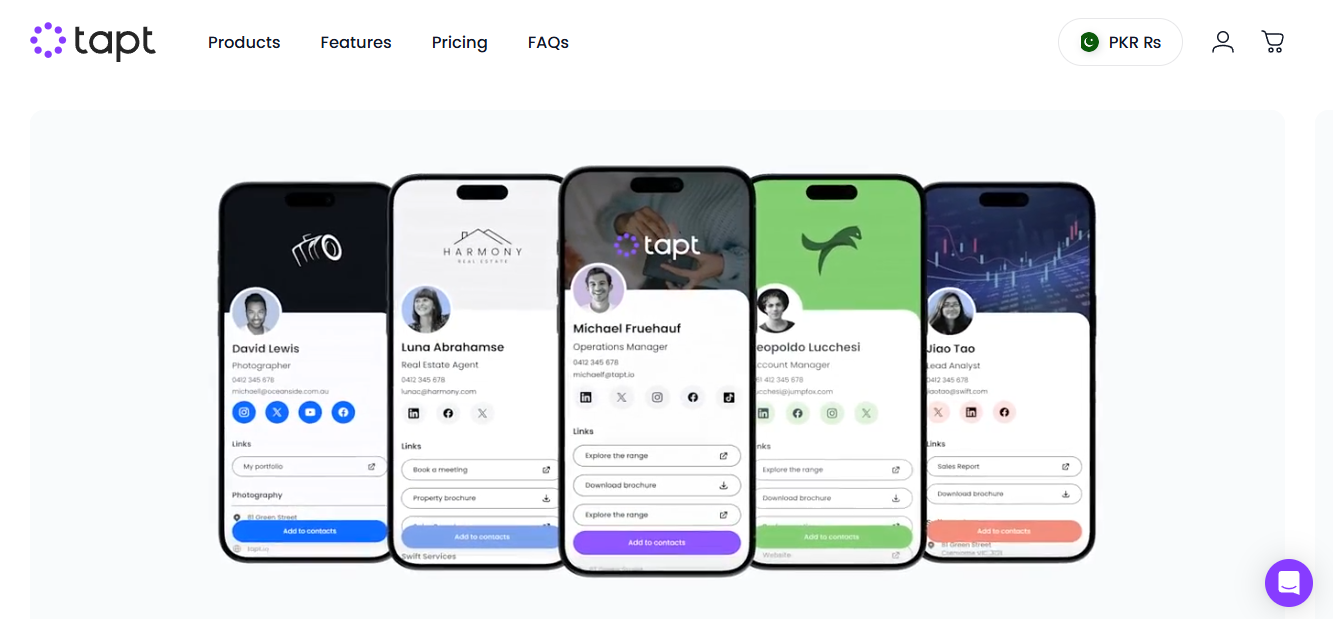
Pros:
Cons:
Tapt is purposefully minimal: build a beautiful, mobile-first card and share by tapping. Compared with HiHello’s ecosystem approach, Tapt narrows its focus to fast individual adoption and a pleasant interface. That keeps onboarding time low and reduces cognitive overhead for teams that are not yet ready for enterprise administration.
Use Tapt when you want a delightful, quick-to-adopt card for individuals value aesthetics and simple sharing.
Freelancers, creatives, and mobile-first professionals prioritize design and ease of use over team automation.
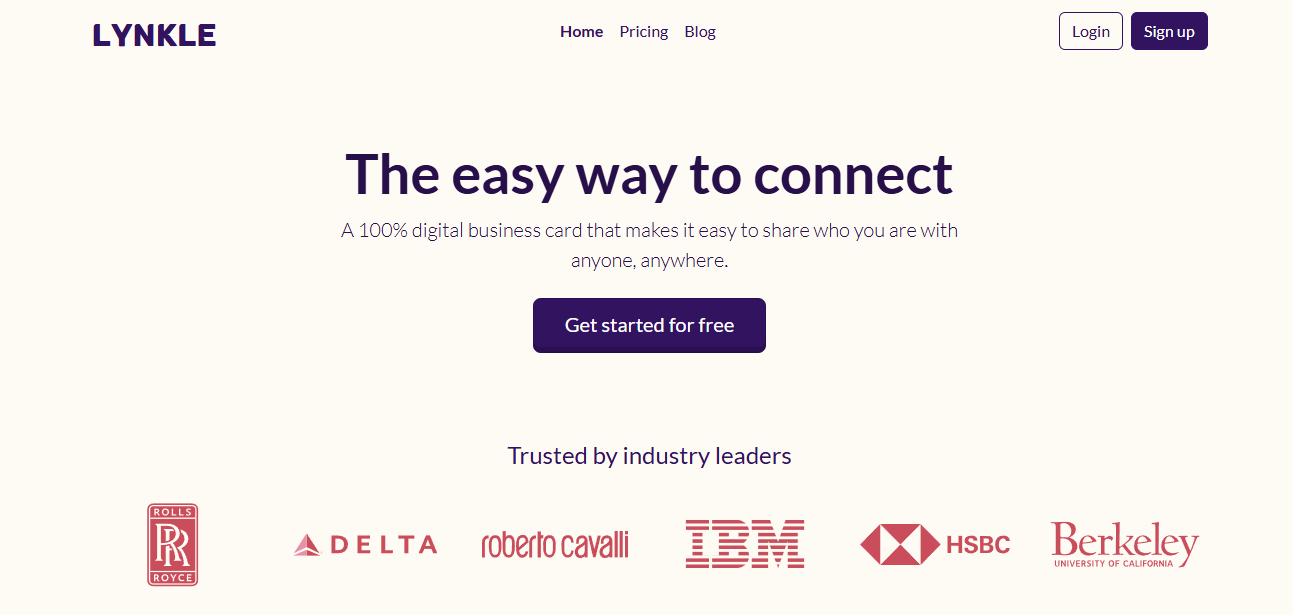
Pros:
Cons:
Lynkle trades physical products for privacy and wallet convenience. If HiHello feels like a public profile, Lynkle offers tighter controls and expiring links that reduce long-term exposure. That focus suits teams that want to limit footprint while still allowing robust sharing and CRM sync.
Pick Lynkle when privacy controls, wallet compatibility, and a usable free tier matter more than physical cards or flashy page design.
Consultants, compliance-conscious teams, and solo professionals want secure, wallet-friendly cards with good free features.
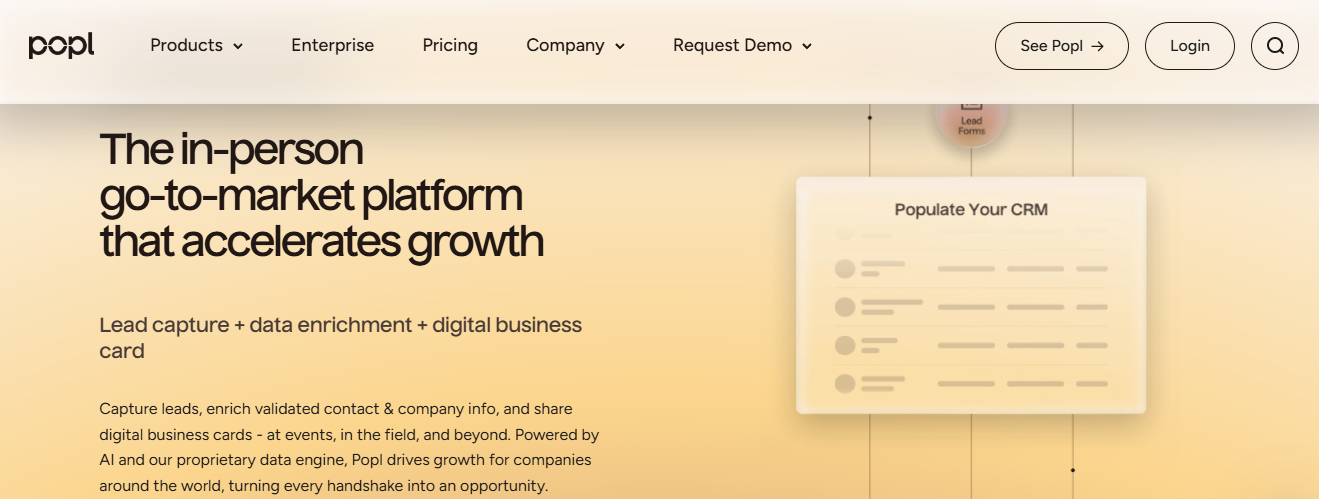
Pros:
Cons:
Popl is engineered for pace. If your team lives at expos or trade shows, Popl’s event tooling converts volume into an actionable pipeline faster than general-purpose cards. HiHello leans into profile design, while Popl sacrifices some aesthetics for event performance: badge scanning, live exports, and immediate follow-up automation.
If you measure events by qualified leads rather than impressions, Popl gives you the capture velocity and reporting to make the numbers matter.
Event teams, expos, and trade show staff need immediate lead capture, badge scanning, and CRM-ready exports.
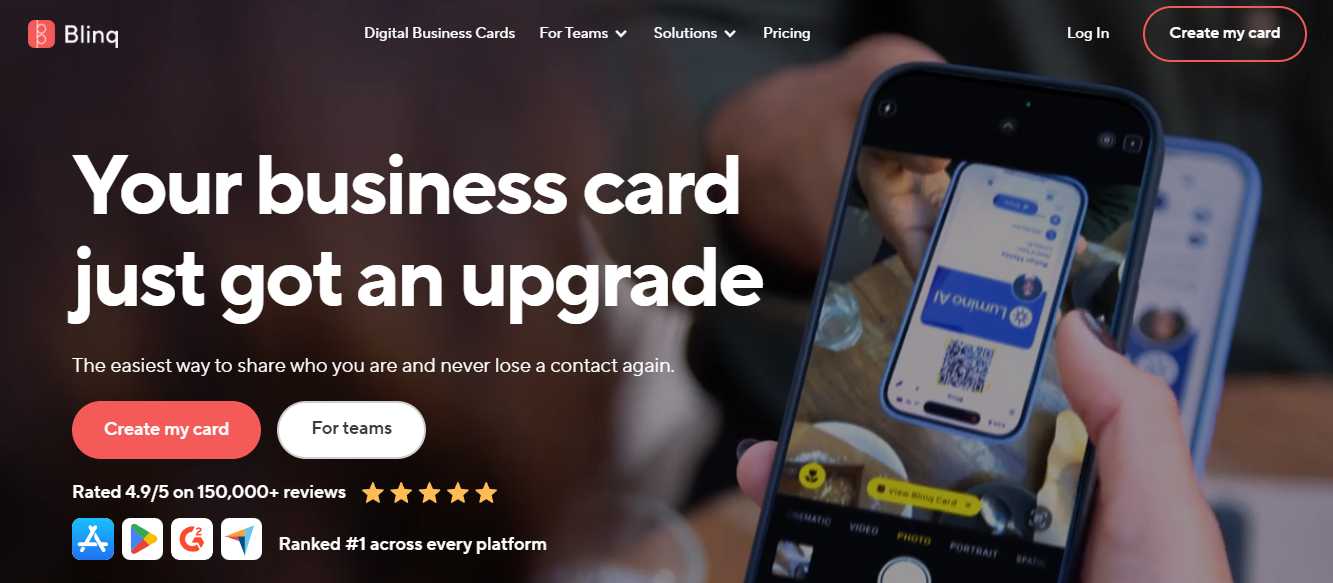
Pros:
Cons:
Blinq prioritizes control. When organizations require SSO, role-based permissions, and auditability, Blinq provides IT with what they need while still enabling mobile sharing. The result is a single-pane admin view that reduces governance work and maintains consistent brand usage. Market shifts matter here as well, Blinq noted in October 2025, in its report on the Blinq Blog, which states that HiHello's user base has decreased by 15% over the past year. Explains why procurement teams are re-examining platform risk and continuity.
Choose Blinq when compliance, centralized management, and reliable policy enforcement are non-negotiable.
IT-led organizations, mid-market companies, and teams with compliance needs that require SSO, role controls, and centralized analytics.

Pros:
Cons:
V1CE is a tactile statement. If brand perception hinges on the physical object, V1CE offers materials that HiHello does not supply. That said, you pay a premium for materials, and the platform positions itself toward individuals and firms that want a physical keepsake that still routes data back into digital workflows.
Opt for V1CE if the card itself needs to convey luxury or premium positioning, and you are willing to accept higher per-user costs.
Executives, luxury brands, and boutique agencies that want premium NFC materials and are willing to invest in appearance as part of their brand signal.
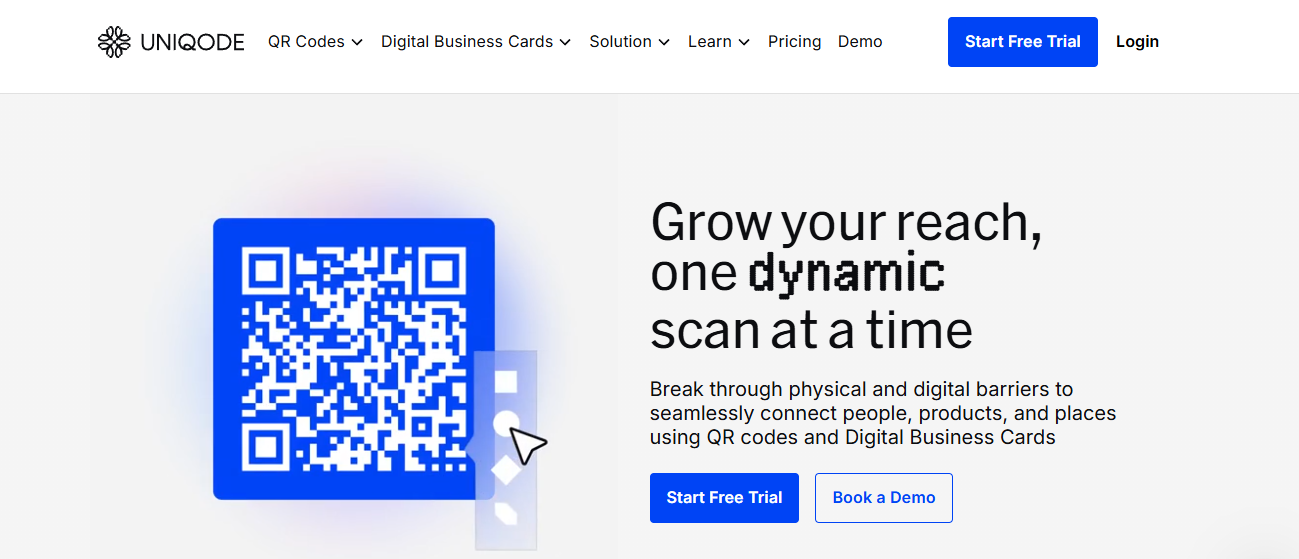
Pros:
Cons:
Uniqode emphasizes security and scale: dynamic QR control plus enterprise compliance. When your workflow requires QR-based offline-to-online campaigns at scale, and audit trails are necessary, Uniqode is the ideal solution. Compared to HiHello, Uniqode is less about individual profile polish and more about predictable, compliant delivery in high-volume programs.
Pick Uniqode when legal or regulated contexts demand certified controls and bulk rollout capabilities.
Healthcare, finance, and regulated enterprises require certified compliance, bulk QR code campaigns, and centralized administrative controls.

Pros:
Cons:
Wave is a budget-first play that still respects security. If cost is the gating factor, Wave provides teams with unlimited cards, eliminating the subscription friction that many platforms impose. That makes it attractive for startups and early-stage companies that need enterprise-like security without enterprise price tags.
Select Wave when you need immediate, no-cost adoption across a growing team and are willing to trade deeper integrations for simplicity.
Startups, bootstrapped companies, and growing teams that need free, secure digital cards and a low-friction rollout.
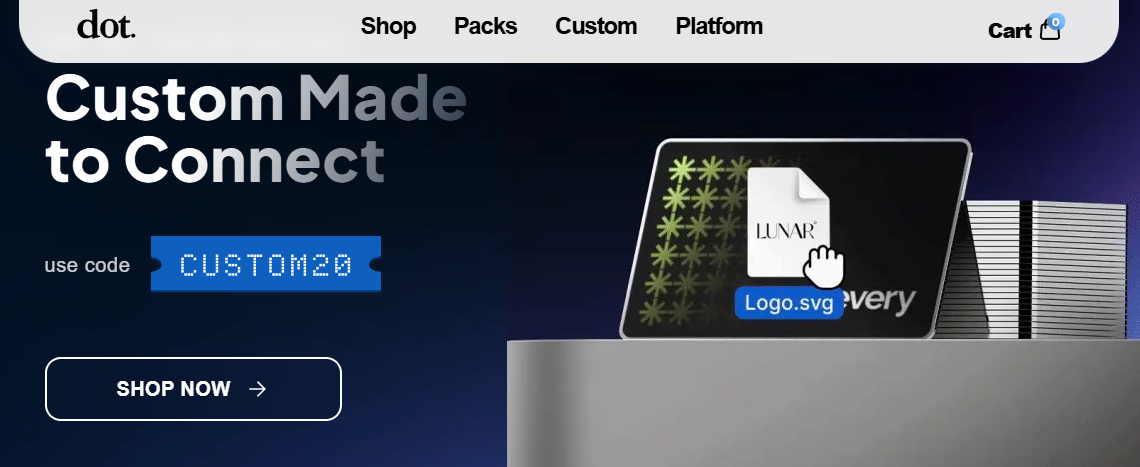
Pros:
Cons:
Dot Card reduces choice to the essentials: tap, scan, and share. For users who want a physical card without recurring fees, Dot’s one-time purchase model is a clear advantage over subscription-first services: Versus HiHello, Dot strips away enterprise features in favor of speed and simplicity.
Use Dot when you want a zero-subscription, straightforward card that works reliably in the moment.
Independent contractors, job seekers, and small teams prefer a one-off purchase and immediate functionality without subscription management.
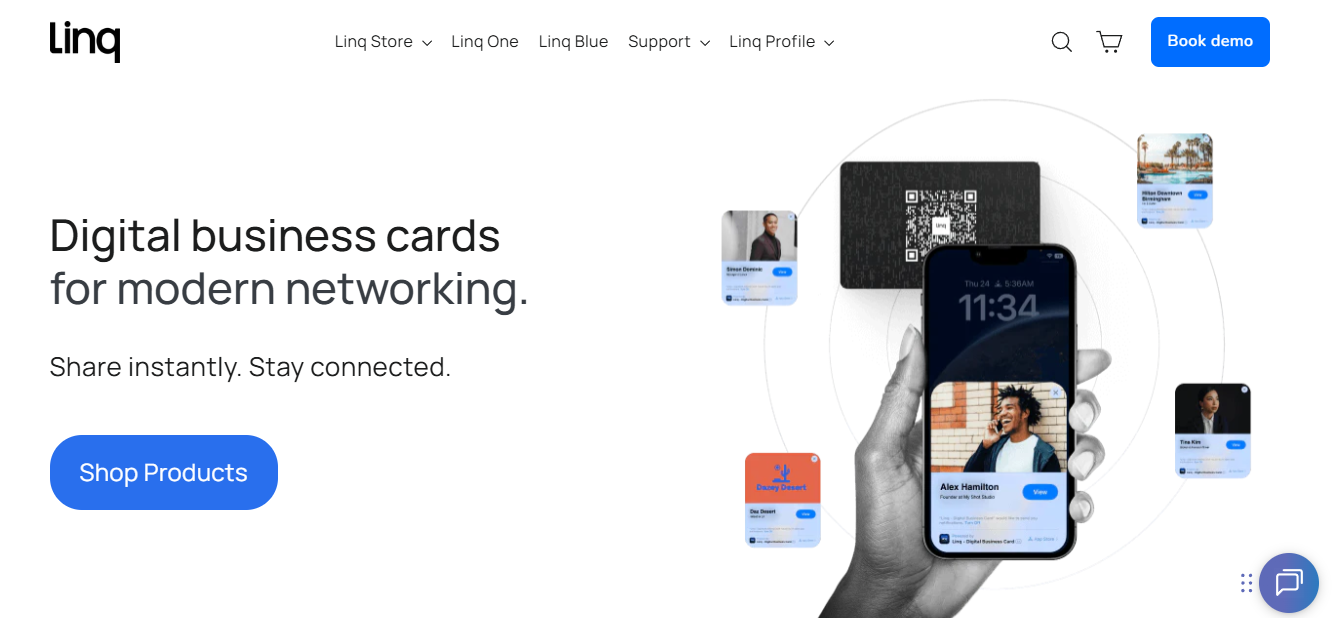
Pros:
Cons:
Linq embeds communication into the card. Instead of relying solely on email, Linq provides a dedicated business number and integrated messaging that keeps follow-ups in a single experience. That reduces context switching and accelerates early engagement. For sales-heavy workflows where texting is the primary channel, Linq keeps conversations and lead records in sync.
Choose Linq if you rely on SMS-first outreach and want automated logging and AI summaries without stitching together multiple tools.
Mobile-first salespeople, consultants, and small teams that use texting and quick follow-ups as their primary outreach channel.
Most teams handle networking with the tools they already know, because change costs time, not just money, and that familiar path is understandable. However, that comfort becomes costly as volume, compliance, and follow-up needs grow, which is why teams that want to scale look for integrated capture, routing, and analytics.
Platforms like Mobilo compress that gap by turning every tap or scan into an action path, not just a profile view. That solution sounds neat until you see how one overlooked step quietly breaks the chain between capture and conversion.
If you're evaluating HiHello alternatives and tired of losing momentum after events, book a Mobilo demo and start with promotional offers, such as 25 Cards Free, valued at $950. When we ran three-month pilots with revenue teams, reps reclaimed hours formerly eaten by manual CRM entry, and that regained selling time is what turns a stack of contacts into a measurable pipeline you can act on.